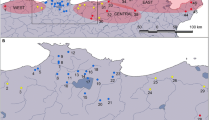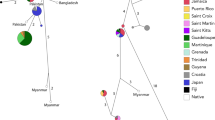Abstract
The invasive European earthworm, Lumbricus terrestris, is now widely distributed in North America. This success may result from high genetic diversity derived from multiple introductions from founder sources across Europe. Using a mitochondrial gene (COI) and microsatellite markers, L. terrestris from seven sites in the Champlain Valley of Vermont USA were scored for genetic diversity and population structure. This region has been a trading crossroads for centuries, thus likely to have received earthworms from multiple origins. COI sequences matched those reported for L. terrestris from Scotland, France, Austria, Denmark, Sweden, and Norway, and 2–5 haplotypes were found at each site. Genetic diversity (microsatellites) was great for each site, but not notably greater than for earthworm populations in general, possibly because there may be allele size homoplasy, or some restriction in the number of alleles possible at any locus. The earthworms were genetically differentiated among the Vermont study sites, even those 0.6–13 km distant. These results support the view that L. terrestris is a successful invasive earthworm because multiple introductions provided ample genetic variation for natural selection and local differentiation among locations in North America. Last, a large number of microsatellite markers is provided, including suggested PCR programs, for free use by future researchers.
Similar content being viewed by others
References
Albers J (2000) Hands on the land. MIT Press, Cambridge
Allendorf FW, Lundquist LA (2003) Introduction: population ecology, evolution and control of invasive species. Conserv Biol 17:24–30
Boore JL, Brown WM (1995) Complete sequence of the mitochondrial DNA of the annelid worm Lumbricus terrestris. Genetics 141:305–319
Butt KR, Frederickson J, Morris RM (1992) The intensive production of Lumbricus terrestris L. for soil amelioration. Soil Biol Biochem 24:1321–1325
Butt KR, Lowe CN, Beasley T, Hanson I, Keynes R (2008) Darwin’s earthworms revisited. Eur J Soil Biol 44:255–259
Cunha L, Thornber A, Kille P, Morgan AJ, Novo M (2017) A large set of microsatellites for the highly invasive earthworm Amynthas corticus predicted from low coverage genomes. Appl Soil Ecol 119:152–155
Darwin CR (1881) The formation of vegetable mould through the action of worms with observations on their habitats. Murray, London
Dupont L, Lazrek F, Porco D, King RA, Rougerie R, Symondson WOC, Livet A, Richard B, Decaën T, Butt KR, Mathieu J (2011) New insight into the genetic structure of the Allolobophora chorotica aggregate in Europe using microsatellite and mitochondrial data. Pedobiologia 54:217–234
Dupont L, Grésille Y, Richard B, Decaëns T, Nathier J (2015) Dispersal constraints and fine-scale spatial genetic structure in two earthworm species. Biol J Linn Soc 114:335–347
Dupont L, Pauwels M, Dume C, Deschins V, Audusseau H, Gigon A, Dubs F, Vandenbulke F (2019) Genetic variation of the epigenic eartheorm Lumbricus castaneus populations in urban soils of the Paris region (France) revealed using eight newly developed microsatellite markers. Appl Soil Biol 135:35–37
Dybdahl MF, Drown DM (2011) The absence of genotypic diversity in a successful parthenogenetic invader. Biol Invasions 13:1663–1672
Eisen GA (1872) Om nagra arkiska Oligochaetre. Öfv. Vet.-Akad. Förhandl Stockholm 29:119–124
Elton CS (1958) The ecology of invasions by animals and plants. Chapman and Hall, London
Enckell PH, Bengston S-A, Duwes P, Niklasson M, Stille B, Wiman B (1986) The dispersal pattern of an anthropochorous species: genetic variation in populations of Lumbricus terrestris L. (Lumbricidae) in the Faroe Islands. Hereditas 104:253–261
Estoup A, Jarne P, Cornuet J-M (2002) Homoplasy and mutation model at microsatellite loci and their consequences for population genetics analysis. Mol Ecol 11:1591–1604
Folmer O, Black M, Hoch W, Lutz R, Vrijenhoek R (1994) DNA primers for amplification of mitochondrial cytochrome c oxidase subunit I from diverse metazoan invertebrates. Mol Mar Biol Biotechnol 3:294–299
François O (2016) Running structure-like population genetic analysis with R. R Tutorials in Population Genetics, U Grenoble-Alpes, pp 1–9
Gailing O, Hickey R, Lilleskov E, Szlavecz K, Richter K (2012) Genetic comparisons between North American and European populations of Lumbricus terrestris L. Biochem Syst Ecol 45:23–30. https://doi.org/10.1016/j.bse.2012,07.018
Gates GE (1976) More on earthworm distribution in North America. Proc Biol Soc Wash 89:467–476
Görres JH, Melnichuk RDS (2012) Asian invasive earthworms of the genus Amynthas Kinberg in Vermont. Northeast Nat 19:313–322
Görres JH, Connolly ST, Chang C-H, Carpenter NR, Keller EL, Nouri-Aiin M, Schall JJ (2018) Winter hatching in New England populations of invasive pheretimoid earthworms Amynthas agrestis and Amynthas tokioensis: a limit on population growth, or aid in peripheral expansion? Biol Invasions 20:1651–1655
Gunn A (1992) The use of mustard to estimate earthworm populations. Pedobiologia 36:65–67
Hale CM (2008) Evidence for human-mediated dispersal of exotic earthworms: support for exploring strategies to limit further spread. Mol Ecol 17:1165–1169
Hale CM, Frelich LE, Reich PB (2005) Exotic European earthworm invasion dynamics in northern hardwood forests of Minnesota, USA. Ecol Appl 15:848–860
Hamilton MB, Pincus EL, DiFiore A, Fleisher RC (1999) Universal linker and ligation procedures for construction of genomic SNA libraries enriched for microsatellites. Biotechniques 27:500–507
Harper GL, Casey CP, Morgan AJ, Kille P, Bruford MW (2006) Microsatellite markers for the earthworm Lumbricus rubellus. Mol Ecol Notes 6:325–327
Holmstrup M, Westh P (1994) Dehydration of earthworm cocoons exposed to cold: a novel cold hardiness mechanism. J Comp Phys B 164:312–315
James SW, Porco D, Decaens T, Richard B, Rougerie R, Erseus C (2010) DNA barcoding reveals cryptic diversity in Lumbricus terrestris L., 1758 (Clitellata): Resurrection of L. herculeus (Savigny, 1826). PLoS ONE 5:15629
Jones G (2001) A history of the vikings. Oxford University Press, Oxford
Kautenburger R (2006a) Genetic structure among earthworms (Lumbricus terrestris L.) from different sampling sites in western Germany based on random amplified polymorphic DNA. Pedobiologia 50:257–266. https://doi.org/10.1016/j.pedobi.2006.02.005
Kautenburger R (2006b) Impact of different agricultural practices on the genetic structure of Lumbricus terrestris, Arion lusitanicus, and Microtus arvalis. Anim Biodiv Conserv 29:19–32
Kirk H, Dorn S, Mazzi D (2013) Molecular genetics and genomics generate new insights into invertebrate pest invasion. Evol Appl 6:842–856
Klein A, Cameron EK, Heimburger B, Eisenhauer N, Scheu S, Schaefer I (2017) Changes in the genetic structure of an invasive earthworm species (Lumbricus terrestris, Lumbricidae) along an urban–rural gradient in North America. Appl Soil Ecol 120:265–272. https://doi.org/10.1016/j.apsoil.2017.08.009
Larkin MA, Blackshields G, Brown NP, Chenna R, McGettigan PA, McWilliam H, Valentin F, Wallace IM, Wilm A, Lopez R, Thompson JD, Gibson TJ, Higgins DG (2007) ClustalX. Bioinformatics 23:2947–2948
McCay TS, Pinder RA, Alvarado E, Hanson WC (2017) Distribution and habitat of the endemic earthwormEisenoides lonnbergi (Michaelsen) in the northeastern United States. Northeast Nat 24:239–248
Mergeay J, Verschuren D, De Meester L (2006) Invasion of an sexual American water flea clone throughout Africa and rapid displacement of a native sibling species. Proc R Soc B 2783:2839–2844
Meshcheryakova EN, Berman DI (2014) Cold hardiness and geographic distribution of earthworms (Oligochaeta, Lumbricidae, Moniligastridae). Entomol Rev 94:486–497
Neal AT, Ross MS, Schall JJ, Vardo-Zalik AM (2016) Genetic differentiation over a small spatial scale of the sand fly Lutzomyia vexator (Diptera: Psychodidae). Parasite Vector 9:550
Nouri-Aiin M, Görres JH (2019) Earthworm cocoons: the cryptic side of invasive earthworm populations. Appl Soil Ecol 141:54–60
Novo M, Velavan TP, Almodovar A, Schulenberg H, Diaz-Cosin DJ, Michiels NK (2008) Microsatellite markers for the drought-resistant earthworm Hormogaster elisae. Mol Ecol Resour 8:901–903
Novo M, Almodóvar A, Fernández RM, Gutiérrez M, Díaz Cosín DJ (2010) Mate choice of an endogeic earthworm revealed by microsatellite markers. Pedobiologia 53:373–379
Nuutinen V, Butt KR (1997) The mating behavior of the earthworm Lumbricus terrestris (Oligochaeta: Lumbricieae). J Zool Lond 242:783–798
Nuutinen V, Butt KR (2005) Homing ability widens the sphere of influence of the earthworm Lumbricus terrestris L. Soil Biol Biochem 37:805–807
Paetkau D, Slade R, Burden M, Estoup A (2004) Genetic assignment methods for the direct, real-time estimation of migration rate: a simulation-based exploration of accuracy and power. Mol Ecol 13:55–65
Peakall R, Smouse PE (2012) GenAlEx 6.5: genetic analysis in Excel. Population genetic software for teaching and research-an update. Bioinformatics 28:2537–2539
Pompanon F, Bonin A, Bellemain E, Taberlet P (2005) Genotyping errors: causes, consequences and solutions. Nat Rev Genet 6:847–859
Pop VV, Pop AA (2006) Lumbricid earthworm invasion in the Carpathian Mountains and some other sites in Romania. Biol Invasions 8:1219–1222
Porco D, Decaëns T, Deharveng L, James SW, Skarzynski D, Erséus C, Butt KR, Richard B, Hebert PDN (2013) Biological invasions in soil: DNA barcoding as a monitoring tool in a multiple taxa survey targeting European earthworms and springtails in North America. Biol Invasions 15:899–910
Reynolds JW (2008) Terrestrial Oligochaeta (Annelida: Clitellata) in North America, including Mexico, Puerto Rico, Hawaii, and Bermuda. Megadrilogica 12:157–210
Richter K (2009) Genetic structure in European populations of the earthworm Lumbricus terrestris. Dissertation, Kassel University, Kassel, Germany
Roman J, Darling JA (2007) Paradox lost: genetic diversity and the success of aquatic invasions. Trends Ecol Evol 22:454–464
Rousset F (2008) Genepop’007: a complete reimplementation of the Genepop software for Windows and Linux. Mol Ecol Resour 8:103–106
Sakai AK, Allendorf FW, Holt JS, Lodge DM, Molofsky J, With KA, Baughman S, Cabin RJ, Cohen JE, Ellstrand NC, McCauley DE, O’Neil P, Parker IM, Thompson JN, Welle SG (2001) The population biology of invasive species. Ann Rev Ecol Syst 32:305–332
Somers CM, Neudorf K, Jones KL, Lance SL (2011) Novel microsatellite loci for the compost earthworm Eisenia fedida: a genetic comparison of three North American vermiculture stocks. Pedobiologia 54:111–117
Souleman D, Grumiaux F, Frérot H, Vandenbulcke F, Pauwels M (2016) Isolation and characterization of eight polymorphic microsatellites markers for the earthworm Lumbricus terrestris. Eur J Soil Biol 74:76–80
Strunk H, Hochkirch A, Veith M, Hankeln T, Emmerling C (2012) Isolation and characterization of eleven polymorphic microsatellite markers for the earthworm Aporrectodea longa. Eur J Soil Biol 48:56–58
Tiunov AV, Hale CM, Holdsworth AR, Vsevolodova-Perel TS (2006) Invasion patterns of Lumbricidae into the previously earthworm-free areas of northeastern Europe and the western Great Lakes region of North America. Biol Invasions 8:1223–1234
Tomlin AD (1983) The earthworm bait market in North America. In: Satchell JE (ed) Earthworm ecology. Springer, Dordrecht
Torres-Leguizamon M, Mathieu J, Decaens T, Dupont L (2014) Genetic structure of earthworm populations at a regional scale: inferences from mitochondrial and microsatellite markers in Aporrectoda icterica. PLOS ONE 9:e1015971-11
Van Oosterhout C, Hutchinson WF, Wills DPM, Shipley P (2004) MICRO-CHECKER: software for identifying and correcting genotyping errors in microsatellite data. Mol Ecol Notes 4:535–538
Velavan TP, Schulenburg H, Michiels NK (2007) Development and characterization of novel microsatellite markers for the common earthworm (Lumbricus terrestris L.). Mol Ecol Notes 7:1060–1062
Velavan TP, Weller S, Schulenburg H, Michiels NK (2009) High genetic diversity and heterogeneous parasite load in the earthworm Lumbricus terrestris on a German meadow. Soil Biol Biochem 41:1591–1595
Wallace AR (1876) The geographical distribution of animals; with a study of the relations of living and extinct faunas as elucidating the past changes of the earth’s surface, 2 vols. Macmillan, New York
Wallace AR (1911) Island life, 3rd edn. Macmillian, London
Wright S (1951) The genetical structure of populations. Ann Eugen 15:323–354
Acknowledgements
We thank Dana Bishop, Woodlands Manager, Shelburne Farms, and Rick Paradis, University of Vermont Natural Areas Director, for aid in use of property under their stewardship. The research was funded by a USDA-Hatch grant from the University of Vermont Agricultural Research Station.
Author information
Authors and Affiliations
Corresponding author
Additional information
Publisher's Note
Springer Nature remains neutral with regard to jurisdictional claims in published maps and institutional affiliations.
Electronic supplementary material
Below is the link to the electronic supplementary material.
Rights and permissions
About this article
Cite this article
Keller, E.L., Connolly, S.T., Görres, J.H. et al. Genetic diversity of an invasive earthworm, Lumbricus terrestris, at a long-term trading crossroad, the Champlain Valley of Vermont, USA. Biol Invasions 22, 1723–1735 (2020). https://doi.org/10.1007/s10530-020-02215-7
Received:
Accepted:
Published:
Issue Date:
DOI: https://doi.org/10.1007/s10530-020-02215-7




